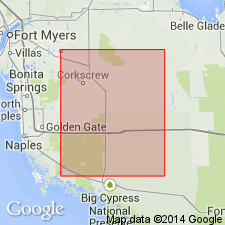
- Usage in publication:
-
- Bone Island Formation*
- Modifications:
-
- Named
- Dominant lithology:
-
- Anhydrite
- Limestone
- AAPG geologic province:
-
- South Florida province
Summary:
Bone Island Formation. Is one of four regionally persistent anhydrite units identified below the Punta Gorda Anhydrite in the subsurface of the South Florida basin. Consists of anhydrite and buff to cream, oolitic limestone with occasional micritic limestone or dolomite. Thickness is 1,350 feet in type well. Overlies Wood River Formation (new). Underlies Pumpkin Bay Formation (new); contact is placed at the top of a regionally persistent 200-feet-thick anhydrite bed. Age is Early Cretaceous (early Coahuilan), based on stratigraphic position.
Type section (subsurface): depth-interval 13,750 to 15,100 ft, Mobil-Phillips No. 1 Seminole well P-565B, in sec. 28, T. 48 S., R. 33 E., Hendry Co., FL. Named from Bone Island in the Big Cypress Swamp.
Source: Modified from GNU records (USGS DDS-6; Reston GNULEX).
For more information, please contact Nancy Stamm, Geologic Names Committee Secretary.
Asterisk (*) indicates published by U.S. Geological Survey authors.
"No current usage" (†) implies that a name has been abandoned or has fallen into disuse. Former usage and, if known, replacement name given in parentheses ( ).
Slash (/) indicates name conflicts with nomenclatural guidelines (CSN, 1933; ACSN, 1961, 1970; NACSN, 1983, 2005, 2021). May be explained within brackets ([ ]).

